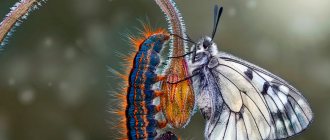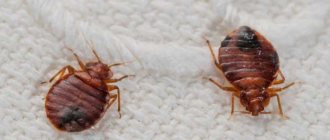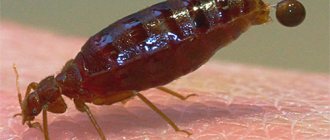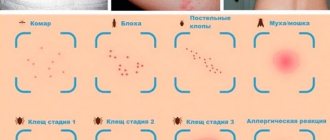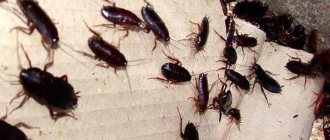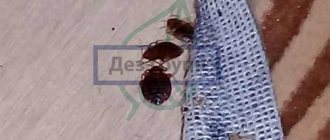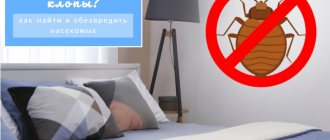- By Vil Malinoshevsky
- About bedbugs
Bedbug larvae are the most insidious part of the entire bedbug population in an apartment. The fact is that many people do not perceive them as bedbugs in general, and some people do not even see them. Although these larvae bite people just like adult bedbugs. And there are always more of these larvae in the room than adult bed bugs. That is, most of the bites from bedbugs on your body specifically are the work of the “hands,” or rather, the proboscis of the bedbug larvae. And you may not even find this main horde of hungry parasites in the apartment.
For example, in the photo below there is a cluster of larvae in a sofa drawer:
Just recently we had a call to a student dormitory. People have poisoned bedbugs several times on their own, but they continue to be bitten and they ask: where to even look for bedbugs if we don’t see them. They bite, but you can’t find them.
We arrive, just lift the sheet on the mattress, turn away the seam and under the seam we see just continuous accumulations of these larvae and eggs. We show the student and say that they are the ones who bite. And the student says that he thought they looked somehow different, like ordinary bedbugs. I didn't even pay attention to these.
Let’s not delve into the question that, in principle, there should be no insects on the mattress, and if anyone lives here at all, then this is not good. It’s just that the situation is indicative - a person sees exactly the larvae of house bugs, but does not understand that it is they, that it is they who bite and it is they who will soon grow up and reproduce.
Consequently, due to this, many problems arise in removing bed bugs. Without seeing and not being able to recognize the larvae themselves, a person can treat even very strong means in completely different places in which these larvae are located. Accordingly, the larvae will not die and the bedbugs will not be removed.
But this problem can be solved relatively simply: you need to figure out what bedbug larvae look like at different stages of their development, where to look for them and how to kill them correctly. Everything else is a matter of technique and a good, effective means.
What do bed bug larvae look like?
Bedbug larvae look very different, despite the fact that during their development they practically do not change their body shape. The fact is that the egg hatches into a larva with a body length of less than 1 mm, and the nymph before the last moult, ready to become an adult, sexually mature bug, is practically no different from the imago.
The photo shows a larva that has just emerged from the egg, still with an empty abdomen:
Therefore, by the way, bedbug larvae are called nymphs - they have the same body shape as adults, but differ in size. In this way, bedbugs differ from insects with complete transformation, for example, the same butterflies and beetles, whose eggs hatch into worm-like larvae that are completely different from adult individuals.
For example, in the photo below there are two adult bugs, the one on the far right is a penultimate instar nymph, and all the rest are nymphs of previous instars:
For example, a larva that has just emerged from an egg looks like a very small, tiny spider or mite. She has a yellow body and if you look at her with the naked eye, she just looks like a small yellow dot. It doesn't look like an adult flat brown bug at all, so it's not surprising that many people don't even think they're bedbugs.
By the way, on light-colored mattresses such larvae easily blend into the background and if you don’t look closely, you may not even notice them.
And if you look somewhere for photographs of bedbug larvae, you will most likely find a macrophoto where these larvae are shown at close proximity. When you see them with the naked eye, you may not even understand that it is them. People with low vision may not notice these guys on the mattress or furniture at all.
Food and typical habitats of bedbug larvae
Due to the fact that the movement speed of the larvae is low, they are not able to move a long distance from the main food source. Therefore, the largest number of them can be found in the place where the owners of the room rest - under the mattress, inside it, in the fold of the bed, in the upholstery of furniture, as well as on the floor or under the baseboard near the bed. It is also important that adult individuals do not show any hostility towards the larvae when entering their territory.
If you find a place where parasites accumulate, you can easily see the difference between adults and larvae, even if you don’t know exactly what the larvae and eggs look like. Such places of accumulation, most often, are distinguished by the presence of a large number of white eggs, dark-colored excrement, and chitinous shells of bedbugs, which remain after the insect molts.
The larva of a domestic bedbug feeds in the same way as an adult insect - human blood. Many people believe that a small nymph leaves a much smaller painful bite point than adult bugs. But they can spoil your sleep and bring unpleasant sensations.
Sizes of bedbug nymphs
As the larva grows, its body increases in size and it becomes more noticeable and more similar to adult bedbugs. If an adult has a body length of 5-6 mm, then the body length of a nymph ranges from 1-4 mm. Moreover, if adult bugs are brown, then the nymphs are either yellow with a translucent body, or crimson-red if they have just fed. They need to be distinguished only from eggs - they are white and similar to grains of rice - and from excrement - they are round and black, similar to fixed points.
By the way, hungry nymphs may not be noticed, for example, on an unpainted tree, on the same bed frame, because they blend in with it in color. But the engorged nymphs are very clearly visible, they simply look like running droplets of blood.
If you look at the nymph at all, you can see through the covering of her body the stomach, the black contents of her intestines and other internal organs. When such a larva sucks blood, you can see how this blood flows into the stomach.
What prevents reproduction
Females and males reproduce quickly only in a comfortable environment. When unfavorable conditions arise, insects slow down the rate of population increase.
Temperature
The optimal temperature for the development and life of an insect is +25…+30°C. Until the ambient temperature drops to +10°C, bedbugs will continue to reproduce, but at a slower rate.
This process stops completely when suspended animation occurs, i.e. when the ambient temperature drops to +5°C and below. Frost from -10°C is fatal for bed bugs.
Humidity
Bed bugs feel most comfortable in warm and dry rooms. Parasites cannot tolerate high humidity; the optimal indicators for them are 40-60%. Low humidity is easily tolerated by adult insects; they replenish the lack of fluid by increasing the amount of blood they consume.
The eggs run the risk of dying, because if there is a lack of environmental humidity, they quickly dry out and the embryo dies. If the humidity is too high (70% or higher), the eggs are susceptible to fungal infections.
Lack of food
A bedbug can live without blood for 3-4 days, a larva - 2-3 days. But even a month of hunger strike does not lead to the death of the bed parasite. If the insect does not receive food within 14-16 days, it will fall into a “inhibited” state - suspended animation. In this state, all processes in the body slow down, and nutrient consumption is reduced to a minimum.
Important! With the lack of food, the ability to reproduce offspring stops.
Anabiosis
Anabiosis is the next stage of “slowing down” the life activity of the bug. This state occurs at a temperature of 0…+5°C. Too high a temperature does not lead to suspended animation, it kills the insect. The larva dies at +45°C, the adult bug lasts up to +70°C.
In this state, the parasite stops moving, feeding and reproducing.
Can a bug reproduce alone?
The bedbug is not a hermaphrodite, so the insect must mate to procreate. The female is inseminated once in her life, and begins to lay eggs daily. If there is one fertilized female in the room, there is normal humidity, plenty of food and an acceptable temperature, then after 2-3 months the number of insects will increase significantly.
If one male bug appears, it will not reproduce.
Bed bugs reproduce quickly but are highly dependent on environmental conditions. Cold indoors (below +5°C) puts the insect in a state of suspended animation, which stops the reproduction process. High or low air humidity (above 70% and below 30%) destroys eggs. Also, the reproduction process stops when there is a lack of food for more than 2 weeks. All these features are often used in the fight against bed bugs, for example, by freezing the room.
Larvae or nymphs: which is correct?
Immature bed bugs can be referred to as either larva or nymph. It's the same thing for bed bugs.
In entomology - the science that studies insects - nymphs are larvae that, after emerging from the egg, immediately have a body structure similar to the body structure of adults. That is, a nymph is a larva that looks like an adult bug.
The photo shows all stages of bedbug development:
All insects are divided into two large groups - insects with complete transformation and insects with incomplete transformation. In the former, the larvae are very different in appearance from adult insects. These are butterflies, for example, or beetles, whose larvae - caterpillars or worm-like stages - do not at all resemble sexually mature individuals. In insects with incomplete metamorphosis, there is no such radical difference between individuals at different stages of development. These are bedbugs, these are cockroaches, grasshoppers. Their larvae are called nymphs and in fact they can be spoken either way.
By the way, an important point: insect larvae with incomplete metamorphosis, nymphs, usually lead the same lifestyle as adult insects. The only difference is the size of their body, the underdevelopment of the reproductive system and some organs (for example, wings) and the inability to reproduce.
Here the photo shows a “white” nymph - a larva that has just molted, whose body covers have not yet become stronger and have not acquired the characteristic dark yellow color:
Bedbug nymphs are no exception in this regard. They live in the same place where adult bedbugs live and feed on the same food. That is, from a very early age, when they are still barely visible to the naked eye, they already bite a person and suck his blood. Their bites are not as painful as the bites of adults, or rather, if there are bumps and redness at the bite sites, these consequences are not as pronounced as after the bites of adult bedbugs. And they itch a little less. Many people don’t even have lumps left on their skin from bites – just a small reddish spot, although their bites from adult individuals swell and itch very much. But in general, bed bug larvae are just as dangerous as the adults.
Differences between bedbug larvae and other parasites
If you find a small red insect at home and are at a loss, “Who is it?” Then this article will just help you figure it out. Here we will talk about “What do bed bug larvae look like?” and about their distinctive features from other parasitic insects.
- The difference from fleas is primarily in their methods of movement and size. Fleas are known to jump, while bedbugs are slow and inactive. Another significant sign is that the flea nymph is much darker than the same size bedbug nymph, which is usually transparent in color.
- First of all, the body shape of both will help us avoid confusing the bedbug nymph with ant larvae. Even the smallest bug has a body much wider than an ant, which has an elongated, oval shape.
- As mentioned above, the bedbug nymph differs from cockroaches in the absence of wings and smaller size. Cockroach nymphs are more mobile, and they have a coloration in the form of a light, well-defined spot on the cephalothorax, which the bug nymph does not have.
- The difference from a tick is primarily in the number of legs. Ticks have 8, like all arachnids, and bedbugs have 6, like all insects.
It should also be noted where each of the parasites discussed above live. As for cockroaches and ants, their main habitats are where there is food and garbage waste. Lice and fleas settle on hairy parts of the body, which bedbugs do not like, preferring places with a minimum amount of hair. This is explained by the peculiarities of their anatomical structure - short legs, which make it difficult for them to crawl through hairy areas.
The main danger of bed bug larvae
The danger of larvae lies primarily in the fact that there are always more of them in an apartment or in a separate room than adult bedbugs.
The fact is that the female bug lays 2-3 eggs every day, and during her 7-8 months of life she gives new life to three to four hundred nymphs. The hatching time of larvae from eggs is 4-5 days, and this incubation period can be extended to one and a half weeks at low air temperatures.
Each nymph develops in approximately 28-30 days, that is, already a month after the female has matured and began to reproduce, her first descendants are also beginning to reproduce.
It turns out that in the population for each female there are several hundred of her own nymphs. And in fact, hundreds of times more of these larvae hatch indoors than there are adults here. Since they have no predators here, they all grow and multiply quickly, and this age ratio is maintained here all the time. This means that several adult bedbugs and several dozen larvae bite you indoors every night. That is, in fact, they are even more dangerous than adult parasites.
What to do to prevent bedbugs from biting
A few words about what can be done to prevent bedbugs from biting at night if the removal of parasites in an apartment drags on for days, weeks or even months. In some non-scientific sources, there are recommendations on what you can smear or treat your body with to prevent bedbugs from biting you.
It should be warned that the effectiveness of such advice on the use of ointments, creams or similar products to repel bedbugs has not been reliably confirmed. Although some people are convinced that it helped them, and they willingly share their experience. Here are a couple of examples of recommended essential oils for bedbugs.
What to put on to prevent bedbugs from biting
- Neem (or Indian Azadirachta) tree oil. One author recommends that after a shower, apply 5-6 drops of this essential oil to your palms and massage into your skin. Treat all parts of the body in this way, and for an additional effect, you can anoint the frame and legs of the bed with oil.
- The smell and taste of lavender oil is believed to repel bedbugs. A few drops are applied to the skin and to the bed frame. The aroma of this oil is persistent, and if it doesn’t protect you from bedbugs, at least your bedroom will smell pleasantly like flowers.
- Similar properties are attributed to tea tree oil. It is also recommended to smear the body and bed, and also dissolve a couple of drops in warm water and spray the area around the bed with this solution from a spray bottle.
Do repellents work against bedbugs - the opinion of scientists
Scientists involved in the problem of bed bugs claim that repellents that repel mosquitoes, fleas or ticks do not work against bed bugs. Here's what Dini M. Miller, Ph.D., a professor in the Department of Entomology at Virginia Tech in the area of urban pest management, has to say:
“Bed bugs do not seem to respond to any insecticide repellents. These results were confirmed in the earlier scientific literature on bed bugs (Usinger 1966), which stated that many repellents were applied to bed frames to prevent the insects from crawling in, but none were effective. Since we have not tested repellents on skin, we cannot say with certainty whether a bug will bite a person treated with repellent. But we found that bedbugs are very persistent little creatures, and I think it is extremely difficult to stop a hungry bedbug using such means.”
This is confirmed by scientists from the University of Kentucky:
“Insecticides used as skin repellents to repel ticks and mosquitoes (such as OFF) do not work against bed bugs. It is not recommended to use such products at night to protect against bites. Sleeping with the lights on also doesn't deter bed bugs."
How to protect yourself from bites
Practical methods of protection against bed bug bites are based on the fact that, due to the structure of their legs, these insects are not able to climb slippery surfaces. Here's what you can do to prevent bedbugs from biting you at night:
- Use a steam cleaner to kill bedbugs and their eggs in the mattress, pillows and bed frame and wash the clothes in hot water. The sleeping area must be 100% free of bedbugs.
- Then place bedbug traps under the legs of the bed. At the same time, make sure that the bed does not come into contact with any surfaces other than the legs (moved away from the wall, bedside tables and furniture, bed linen does not hang on the floor).
- Cover the mattress in a cover made of thick material with a zipper or a sealed polyethylene bag.
Just remember that such measures will not rid your apartment of bedbugs, but will only temporarily protect you from bites. To eliminate bloodsuckers for good, a carefully thought-out strategy using chemical and physical methods of destruction is required. If you can’t get rid of parasites on your own, seek professional help.
Please rate the material
Nymphs as a cause of allergies
In addition, during its development, it changes its chitinous covers 5 times. The dry skins remaining from them are destroyed over time and mixed with dust, and when air moves, they can rise and enter the human respiratory tract.
These skins contain very aggressive allergens, which often cause chronic rhinitis with runny nose and nasal congestion, dermatitis. And over time, such chronic rhinitis without treatment provokes the development of asthma.
Here, in a cluster of bedbugs, numerous remains of their chitinous coverings are visible:
And in this regard, larvae are much more dangerous than adult bedbugs: each larva leaves behind 5 skins, and there are more of these larvae in the room than adults. That is, even the remains of dead bugs are less numerous than the discarded chitinous covers of the larvae.
Consequently, they are the ones who leave the largest number of allergens in the house, and if they live here for a long time, then the amount of these allergens constantly increases exponentially.
How do bedbugs reproduce?
So, how do bedbugs reproduce and what are the features of this process? Characteristic of parasites is the so-called traumatic method of reproduction or traumatic insemination, which can lead to the death of the female.
The rate of population increase can be directly influenced by factors such as the availability of a sufficient number of food sources, optimal temperature, and humidity.
However, according to scientific research, the parasite population has been growing rapidly over the past ten years.
Pairing
Mating of bedbugs is a rather surprising, very interesting phenomenon from a biological point of view, which allows the population of insects to grow rapidly, as well as to form new colonies.
A typical reproduction option for bedbugs is traumatic insemination, which is typical for extremely rare species of the insect world.
The essence of this process is as follows: during mating, the male parasite fixes the female, after which he literally pierces her abdomen with a needle-shaped appendage, injecting seminal fluid.
This type of mating is potentially dangerous for the female, since there is a high probability of bacteria penetrating the wound.
The female insect is saved from death by the presence of a specific organ that contains immune cells that prevent infection of the female’s body with foreign biological material.
When sperm enters directly there, the liquid is disinfected, after which it further moves to the reproductive system through hemolymph.
Bedbug reproduction process
So how do bed bugs reproduce? After the eggs mature, the female begins to lay them at intervals of three to four units per day. Over the course of a lifetime, one individual may well reproduce up to three to four hundred of its own kind.
The breeding season for bed bugs occurs most often at night, as these parasites cannot tolerate sunlight.
A distinctive feature of bedbugs is their resistance to the basic genetic law, namely: the emergence of full-fledged healthy individuals from closely related relationships, that is, inbreeding. According to research data, within each insect population there is an extremely low level of diversity of genetic material.
Due to the possibility of mating between closely related members of the species, colonies grow at an incredible rate.
How quickly do bedbugs reproduce?
Probably everyone who has encountered the appearance of these unpleasant insects is interested in the question of how quickly bedbugs reproduce at home. The incubation period during which bedbug eggs mature is about two to three weeks.
Next, the eggs hatch into so-called nymphs, which reach the state of a sexually mature individual in five to seven weeks. During this time, the larvae undergo five molts. However, such a reproduction rate is possible only if there is a sufficient amount of food.
The total duration of insect development stages is about one and a half months.
Can bedbugs reproduce without food?
The speed and timing of bedbug reproduction in an apartment is directly influenced by the presence of a sufficient amount of food. Parasites can easily withstand long hunger strikes, but they reproduce much more slowly. Nymphs, for example, develop only when food is available.
Females deprived of nutrition may die after fertilization.
Video
How do bed bugs reproduce?
Why are larvae more difficult to remove?
There is another nuance: it is the larvae that may be the first to appear after treatment. The fact is that bedbug eggs are very resistant to the action of insecticides. Those products that reliably kill adult bedbugs and larvae do not affect eggs. Today there are no insecticidal preparations on the market with a proven ovicidal effect. This means that after treatment, all larvae and adult bedbugs in the apartment die, but after a few days, nymphs begin to hatch from the eggs laid before treatment.
If the treatment was carried out well and the correct remedy was selected, all these nymphs die. Good exterminators use strong preparations with a pronounced residual effect to poison bedbugs, that is, these agents poison bedbugs even when they dry out after treatment and the insects run over the layer of the dry preparation. At least, we in Dezincity use only such products against bedbugs.
When the larvae hatch, they begin to look for a person, crawl towards him, get dirty in the product and die from it. Plus, the newly hatched larvae run very slowly, and once on the treated surface they collect a very large amount of the drug. That is, they almost all die.
But sometimes some of these larvae can survive. There may be several reasons for this:
- There were a lot of bed bugs before treatment, they left thousands of eggs and some isolated nymphs were able to avoid contact with the drug;
- The treatment was unprofessional, the places where the larvae move were not treated, and they simply did not get dirty with the product;
- During processing, a product was used that does not have a residual effect. Many folk remedies for bedbugs do not have this effect and do not allow you to poison the larvae the first time.
Sometimes several of these reasons occur at once. In all these cases, after treatment, some of the hatched larvae may survive and must be destroyed by repeated disinfestation before they become adults and begin to lay eggs.
Life cycle of bedbugs
The lifespan of an adult insect is 12-14 months.
The maturation period takes about 30-35 days, but if conditions for development are unfavorable, the larva goes into suspended animation. During this period, life processes slow down, but as soon as conditions change for the better, the larva comes to life and goes through the entire life cycle starting from the interrupted stage.
The development process of a parasitic insect occurs in 3 stages. First, the fertilized female lays eggs. The egg then develops into a larva (nymph). After a short period of time, the larva becomes an imago (mature individual).
There is no intermediate transformation into a pupa, so entomologists classify bedbugs as insects with an incomplete cycle of transformation.
The bedbug's diet consists exclusively of blood. It is necessary for it at all stages of maturation and for further viability.
Life cycle of a bed bug.
Reproduction through violence
The method of reproduction of these insects can be called violent. The mating male uses a painful and quite traumatic method of insemination: he attacks the female, pierces her abdomen with the genital organ and injects sperm into the resulting hole.
The injected seminal fluid is enough for the female to reproduce offspring for the entire life cycle. She spends it gradually, as needed. In starvation conditions, the digested part of the seed can even become additional nutrition for the female.
Thus, a female mate only once in her entire life. Males are capable of sexual intercourse up to 200 times a day.
Fertilization occurs through severe trauma to the female abdomen.
Males are promiscuous in sexual relations and can attack another male or a nymph incapable of fertilization.
A violent act can lead to its death, so nature has endowed the larva with the ability to secrete a repellent enzyme that causes a feeling of anxiety in the male.
Sexual intercourse with a male leads to mixing of seminal fluid in the body of the injured party.
As a result, during the next mating, the most viable sperm enter the female’s spermatheca.
Appearance of eggs and larvae
The egg develops in the female body for no more than 3-4 days, after which she lays it. The egg capsule resembles a translucent grain of rice, no more than 1 mm in length, making them difficult to detect.
At this stage of development, the bug is practically invulnerable: the shell of the egg is resistant to shock, temperature changes and does not allow pesticides to enter. Therefore, even after treatment, parasites may reappear in the house.
The larva that hatches from the egg is called a nymph. She looks like a mature individual, but is smaller in size. The color of the insect at this stage is almost transparent; you can even see the sucked blood in the abdominal cavity.
A bedbug can lay up to 5 eggs every day.
Larvae require a lot of nutrition to grow. At one time they consume less blood than adult arthropods, but feed more often.
Nymph bites are painful and immediately cause itching and burning, because... their saliva does not contain anesthetic. When a sexually mature bug bites, it injects a substance similar in effect to an anesthetic.
Whitish from birth, the larvae begin to change color due to molting. The chitinous shell does not stretch as the bug grows, so the insect sheds it every 5-6 days.
With each molt, the shell becomes darker in color. After the fifth molt, the nymph is ready to reproduce.
Adults
A sexually mature bug reaches a length of 4-6 mm. The color of its shell varies from red to almost black. The color depends on how much the sucked blood has been digested. The darker the color of the shell, the more blood was digested.
The insect's body is flat, which makes mechanical destruction difficult and makes it easier for the parasite to penetrate narrow crevices. When eating, the segmented abdomen stretches and swells as it fills with blood.
An adult bloodsucker has a pungent and unpleasant odor. Its odorous glands secrete a specific secretion, with the help of which insects scare off the enemy, communicate with each other and orient themselves.
When is it necessary to re-treat to destroy all larvae?
Incubation of bed bug eggs lasts 7-12 days, up to a maximum of two weeks in normal home conditions. That is, two weeks after treatment, larvae have already hatched from all eggs and there will be no developing eggs left here.
The larvae themselves develop to adulthood in about 30 days.
This means that re-treatment must be carried out precisely in this time window - no earlier than two weeks after the first disinfestation, but no later than 30 days. If done earlier, there is a risk that at this time there will be single eggs left in the apartment, from which the larvae have not yet hatched, and they will hatch after the second treatment. If carried out later than a month later, then by the time of the second baiting, individual adult bedbugs may already appear in the apartment, which will lay new eggs and, similarly, larvae will hatch from them after the second treatment.
Our practice at DisinCity shows that re-treatment is usually not required. According to our statistics, in 83 cases out of 100, after our first treatment, bedbugs no longer bite people. Only in 17% of cases is there a need for re-processing. In fact, it is required if you were poisoned by bedbugs, but after a week and a half the bites began to appear again. If you are absolutely sure that bedbugs are not getting to you from your neighbors, then these bites are left by small larvae. You can try to find them and if you find them, call the service and carry out repeated disinfestation.
Description of bedbugs and photos
Bedbugs feed on blood, their survival is directly related to humans, and in rare cases, to animals and birds. Both males and females feed on blood, eating up to 7 mg at a time. Even larvae that have just hatched from eggs are parasitic.
The lifespan of one individual is 12-15 months. The average length of a bug individual is 5 mm. The color of bedbugs is usually dark brown, but depending on age and degree of saturation, it changes from transparent white and light yellow to brown and bright red. The bedbug has two canals that form the jaws - one that receives blood during a bite and one that releases pain-relieving saliva into the wound. The body of a hungry bug or a bug in “anabiosis” is thin and too flexible, it is not easy to crush it.
The flat shape is what allows the bug to squeeze through a very thin crack. It is not a problem for them to get inside a book or some gadget. Migrating with a person and his things is the only way for bedbugs to survive. Bedbugs enter apartments and other premises passively - they are carried along with old furniture and belongings, and are carried by people. At risk of infection are public accommodation facilities - hotels, hostels, hostels, communal apartments, etc. At the same time, not a single building is insured against the infestation of a house by bedbugs. In a residential building, bedbugs move from apartment to apartment and even from floor to floor. The speed of movement of a bug on a flat surface is about 1 meter per minute. For example, having infested a building, bedbugs move between rooms in it through ventilation ducts and openings in utility lines, and in the summer - along the outer wall of the house, entering apartments through windows. Often, bedbugs actively spread due to hunger or treatment with repellents.
How to properly get rid of larvae?
This second treatment is usually simpler than the first. The fact is that small larvae stay very compactly near the sleeping places. Due to the fact that they run very slowly, they cannot crawl more than one and a half to two meters during the night.
Therefore, they should be either on the mattress or on the sofa or bed on which the person sleeps.
Later, adult bedbugs can hide for a day or more, right up to neighboring rooms and even neighbors in the apartment, but the larvae are located almost right on the sleeping places. Here it is quite easy to treat them with a product and kill them.
In this case, the larvae concentrate in relatively quiet places where light does not reach and people rarely look. For example, they are extremely rare on clothing and directly on bed linen, in pillows and blankets.
Most of them are found on the seams of mattresses and sofa upholstery. The larvae are very small and the space under the overhanging seam is enough for them to hide and stay here during the day, digest blood and prepare for the next feeding. Here, under the seams of the mattresses, you should look for them first, and then inspect the soft elements of the sofa, its internal cavities, the bed frame, armrests and fasteners.
Starting from the second instar, the larvae can already hide behind baseboards and under loose wallpaper and behind ceiling moldings - here you also need to look for them, even if all these decorative elements need to be removed for this.
It is clear that the longer you delay re-treatment, the larger the larvae will become during this time and the further they can run away from the sofa and bed after being bitten. Consequently, the more time passes after the first treatment, the more voluminous and large-scale the second disinsection will have to be.
In this case, the larvae die from all the same drugs that effectively poison adult bedbugs.
Breeding conditions
Colonies of parasites are quite sensitive to the slightest changes in their environment. There are several factors that can slow down or completely stop the reproduction process.
- Air humidity is too low;
- Low temperature up to 10 degrees;
- Too hot, over 50 degrees;
- Bright, sunlight;
- Lack of food.
Insects form nests in places where they hide during daylight hours among many other insects, larval skins, and bedbug excrement. Eggs are laid here and larvae hatch.
The main condition for fast and productive reproduction is regular feeding of the female and warm climatic conditions. The most suitable and comfortable place for bedbugs to breed in an apartment.
Unlike other parasites, such as cockroaches, which can appear in dampness and garbage and feed mainly on food waste, the bedbug is indifferent to sanitary conditions.
Bloodsuckers can start and multiply in a completely clean and tidy room, as long as they are closer to a person. The temperature that is usually maintained in a living space is the most favorable for bedbugs to breed quickly.
Knowing how quickly bed bugs multiply, you should not hesitate and immediately start fighting pests.
